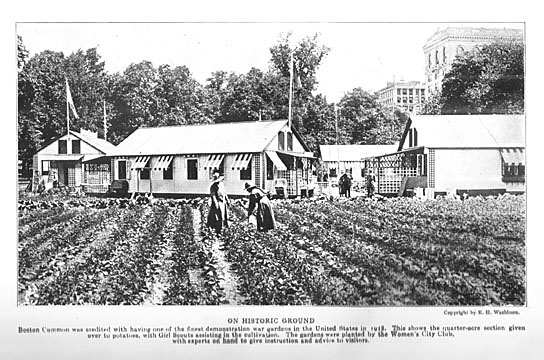Urban farming is a hot topic in a wide range of discussions, from reducing greenhouse emissions to community revitalization. While urban agriculture may seem like a relatively new topic for Worcester, the idea of growing food in cities has a long history – and a good deal of research behind it. Check out these 10 fast facts about urban farming that you probably didn’t know before.
-
The average American city could grow enough vegetables to meet the recommended vegetable intake if it devoted just 10% of its city limit area to urban farming. [ref]
- For Worcester, that translates to about 101,000 acres, which sounds really daunting until you consider that indoor farming, vertical farming and other technological advancements greatly reduce the geographical footage needed to reach that figure. Could Worcester be completely self-sufficient through urban farming and urban gardening? No one is suggesting that – but investing in locally farmed food is a big plus in the area of food security.
-
Urban farming initiatives represent bold city leadership. [ref]
- In 1893, Mayor Hazen Pingree established urban truck gardens on vacant lots throughout Detroit, Michigan, despite local opposition. When Pingree couldn’t raise the necessary funds to start the gardens, he auctioned off his own prize horse to the cause. Pingree’s Potato Patches helped feed the poor of Detroit during a devastating winter where massive food shortages left other cities scrambling to feed their residents.
-
Urban farms can be profitable.
- It’s popular to think of urban gardening and urban farms as non-profit projects for the public good, but urban farming can be profitable. In 2012, a survey of 370 urban farmers found that farming was the only income for 120 of the farmers, and the average revenue from farming was around $54,000. As infrastructure expands to make it easier for urban farmers to connect with customers, producers will find it less expensive to market their goods and see more profit from their labor.
-
The U.S. has turned to urban farming in the past during wartime and depressions with good results.
- Most people are familiar with Victory Gardens, but few realize the impact that gardening initiatives had on alleviating food shortages and hunger during and after the World Wars. In 1918, for example, Woodrow Wilson’s call for home front gardening resulted in more than 5 million small, largely urban, plots, which produced more than 528 million pounds of produce.

- ON HISTORIC GROUND
Boston Common was credited with having one of the finest demonstration war gardens in the United Stes in 1918. This shows the quarter-acer section given over for potatoes, with Girl Scouts assisting in the cultivation. The gardens were planted by the Women’s City Clubs, with experts on hand to give instructions and advice to visitors.
-
Urban farming can reduce the hot-spot effect of pavement, asphalt and deforestation. [ref]
- That’s right. Devoting more urban space to growing food and other plants can literally reduce the temperature in cities. A study done by the University of Cardiff in 2007 showed that rooftop gardens and vertical garden walls can significantly reduce the temperature of the surrounding air – by as much as 20 F. The more area devoted to green rooftops and green walls, the more widespread the effect can be. In addition to cooling the air around them, buildings with rooftop gardens and garden walls reduce the amount of energy used for air conditioning and cooling in hotter months.
-
The average urban garden for home use can produce $200 to $400 per year in fresh produce.
- Your mileage may vary, of course, and few people raise that much food in their early years. Startup costs for a city farm or garden can be high, because so much of the soil needs to be decontaminated, but the costs drop considerably after the initial investment. The startup costs for a commercial urban farm are also high, but the yield per acer is substantially higher than in a home garden, thanks to intensive farming methods like vertical gardening and aquaponics.
-
Community gardens and urban farms raise property values.
- Numerous studies have found that access to urban gardening, community gardens, community supported agriculture and other forms of urban agriculture can boost the property values of properties nearby. One study in particular found that starting a community garden positively impacts the selling prices of homes within 1,000 feet. They further found that the more disadvantaged the neighborhood and the more attractive the garden, the higher the impact on the property values.
-
Urban farming in other countries feeds far more people than in the U.S.
- A presentation by the Resources Centres on Urban Agriculture and Food Security stated that farms in Shanghai produce 60% of the vegetables and fruit consumed by its residents, as well as 100% of the milk and 90% of the eggs. In Hanoi, the numbers are 80% of the produce, 40% of the eggs and 50% of the pork, poultry and fish. In both cities – and in other urban areas around the globe – urban agriculture provides jobs for millions of people who would otherwise be unemployed.
-
There’s a lot of vacant land available for food production in Worcester.
- A 2013 WPI project sponsored by the Worcester Food and Active Living Policy (now the Worcester Food Policy Council) identified more than 2,000 acres of vacant land scattered across Worcester in parcels ranging from 1/4-acre to more than 10 acres. That number doesn’t include privately owned land, structures that can be used for indoor farming, curb strips and highway medians, or any of the other extremely creative urban agriculture projects happening around the country.
-
Worcester County already has a head start on the infrastructure needed to make urban farming a profitable venture for small urban farms.
- Thanks to the groundwork laid by so many of our partners, Worcester’s got a good start on the factors that make urban farming successful. Those include a network of partners willing to work with new farmers, a commercial kitchen and incubator where producers and entrepreneurs can use equipment and get help and advice in creating value-added produce, a growing assortment of local restaurants and eateries committed to using locally produced foods, farm-to-school programs, aggregators like Lettuce Be Local who facilitate connections between farmer/vendors and customers, and so much more. The Urban Agriculture Ordinance is one more step on the road to making urban farming a realistic option for Worcester area businesses and farmers.



